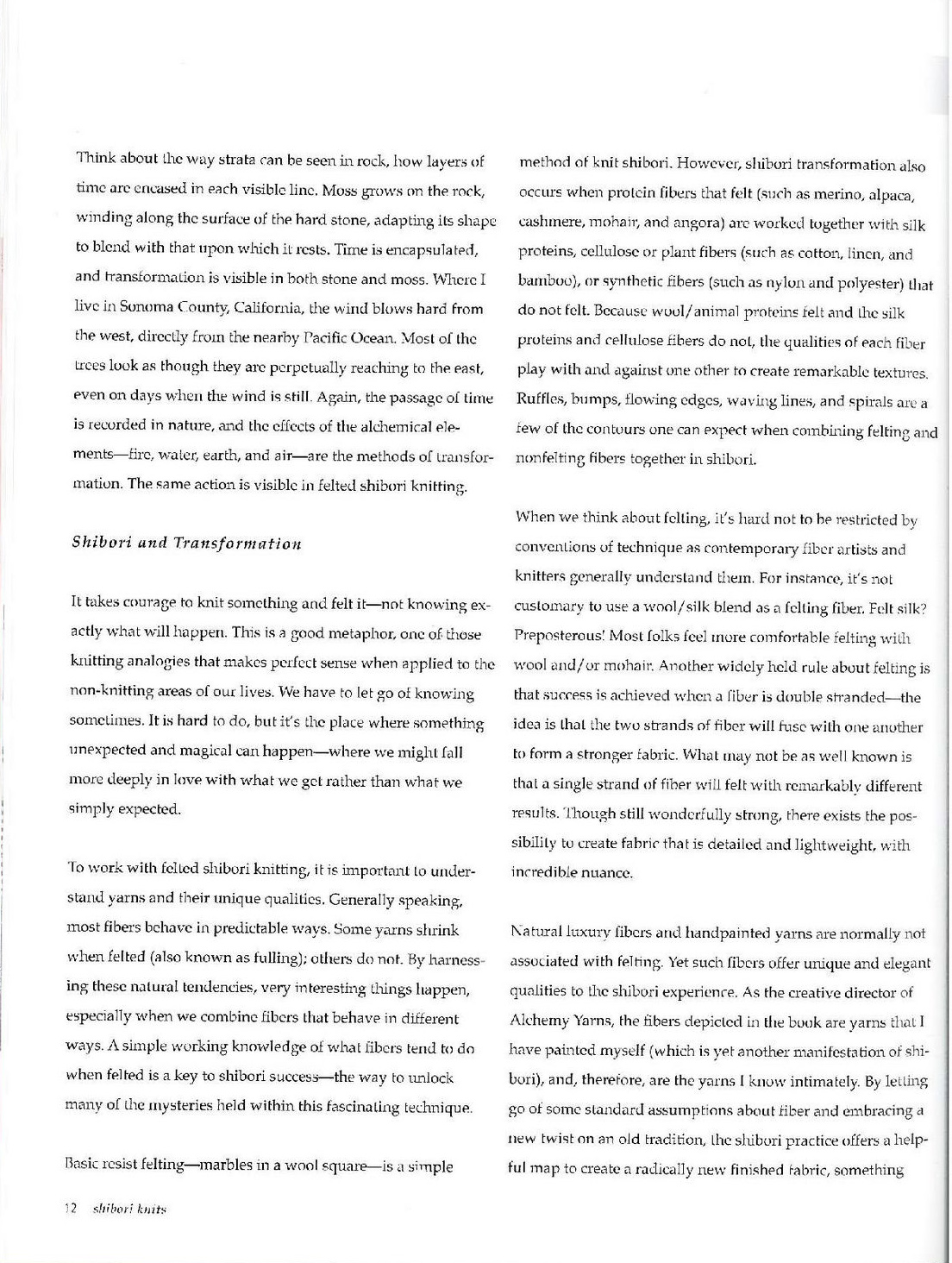S20C 409120813141

Think about Ihc way strata ran be seen iii rock, ho w layers of timc arc cncased in each visiblc lino. Moss grows on the rock, winding along thc surface of the hard stone, adapting its shape to blend with that tipon which it rests. Time i;s encapsulated, and transformalion is visible in both stone and moss. Where I livc in Sonoma County, Califomia, the wind blows hard from the west dircclly from the nearby Pacific Ocean. Most of thc Lrees look as though they arc perpctually reaching to the easb even on days wlien tlie wind is still. Again, the passage of limę is reeorded in naturę, and thc effeets of tłie alchemical ele-ments—tire, walor, earth, and air—are the methods of Uansfor-mation. The same action is yisiblc in felted shibori knitting.
Shibori and Transformat i on
It tukes courage to knit something and felt it—not knowing ex-actly what will happen. This is a good metaphor, one of those knitting analogies that makes pcrfcct sense when applied to thc non-knitting areas of out lives. We have to let go of knowing somclimes. It is hard to do, butit's thc place where something unexpected and magical can happen—where we mighl fali moro deeply in Iove with what wc gcl rather than what we simply expected.
lo work with fcllcd shibori knitting, it is important lo under-stand yarns and their unique qualitics. Generally speaking, most fibers bchavc in predietable ways. Some yarns shrink when felted (also known as fulling); others do not. By harness ing thesc nalural tendenries, very interesting ihlngs happen, especially when we combinc fibers that behave in different ways. A simple working knowledge of what fibers tend to do when felted is a key to shibori success—the way to unlock many of the mysteries held within this fascinating technique.
Basic resist felting—marbles m a wool square—is a simple method ot knit shibori. Howcver, shibori transformation also occurs when protein fibers that felt (soch as merino, alpaca, cashmere, monair, and angora) arc worked together with silk proteins, ccllulosc or plant fibers (such as cotton, iincn, and bamboo), or synthetie fibers (such as nylon and polyester) that do not felt. Bccausc wool/animal proteinę teit and thc silk proteins and relluiose fibers do not, the qualities of each fiber piay with and against one other to create remarkablc textures. Ruffles, humps, flowing edges, waving lines, and spirals are a rew of thc contours one can expect when combining felting and nonfelting fibers together in shibori.
When we think about felting, it's hard not to be restricted by convcnlions of technique as contemporary fiber artists and knitters generally undcrsland thein. For instance, it's not cuslomary to use a wool/silk blend as a felting fiber. Felt silk? Prepos tero lis! Most folks feel morę comfortable felting willi wool and/or mohair. Another widely hcid rule about felting is that sucress is achieved when a fiber is double stranded—the idea is that the two strands of fiber will fusc with one another to form a stronger fabric. What may not be as well known is that a single strand of fiber will felt with rcmarkably different rpsults. Though still wonderfully strong, there exists the pos-sibility to create fabric that is detaiied and lightweight, with incredible nuancc.
Natural luxury fibers and liandpainted yarns are normally not associated with felfing. Yet such fibers offer unique and elegant quaiities to thc shibori experienre. As the creative director of Alchemy Yarns, the fibers depiclccl in the book are yarns tlial I have painted myself (which is yet another mani fes ta fi on of shibori), and, therefore, are the yarns I know intimatdy. By lelling go of some standard assumpt:ons about fiber and embracing a new twist on an old tradition, the słiibori practice offers a help-ful map to create a radically new finished fabric, something
; 7 •shibori knit*
Wyszukiwarka
Podobne podstrony:
79162 S20C 409120813211 cotton or silk yarn ii: mist be norfelling ya n). weave nc neerie through :h
12621 S20C 409120813161 surrender to shiborielegant explorations in shibori possibility This rhapter
9 3 An important issue about negoliation is changing ihe way the think about us. The impression we m
2.1.1. Reading comprehension 1. What did Democritus think about the structure of m
S20C 409120813150 Yarn contcnt There are different iaclors for felting and nonfelting fibers lo cons
S20C 409120813151 Szoatching Information You read this in every knitting book: Make a swatch! Swatrh
S20C 409120813171 bouquet wrap Something ahout knitters andflozoers i ust go togefher. I suppose the
S20C 409120813182 happy colo red marbies scarf continued Level f-asy Knitted Measurements Beforefeit
S20C 409120813190 Fetting Pleosc rcter to the guidelines for wasitirt# ma dmie felting on pagc 113.
S20C 409120813193 wood grain scarf continued Lcvel Easy Knitted Measurements Bejóre fil ting 80"
S20C 409120813240 The Op Art Belt (page 54) uses Fair Isle to create a woven ełfect. s/tibor: crcntw
więcej podobnych podstron